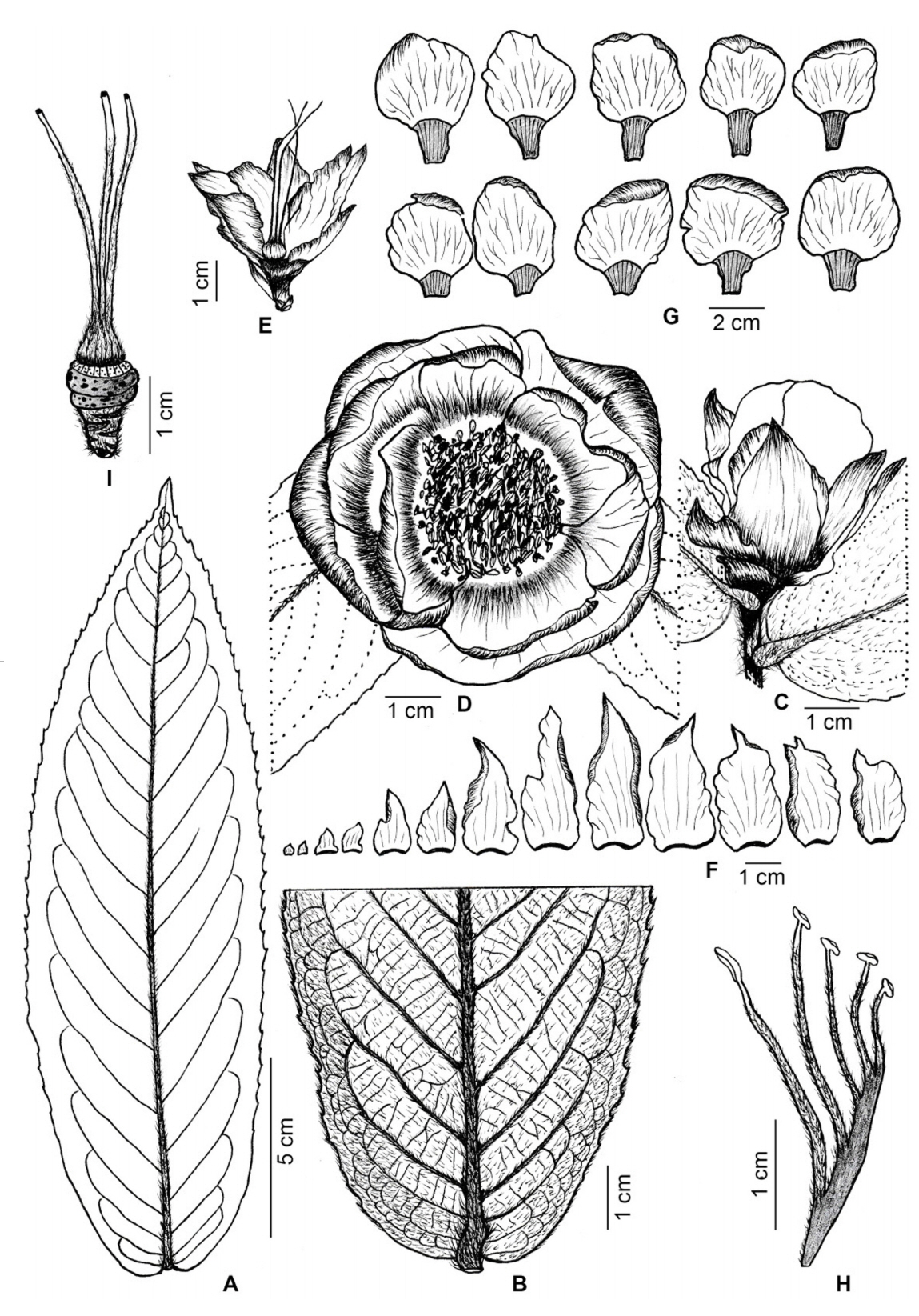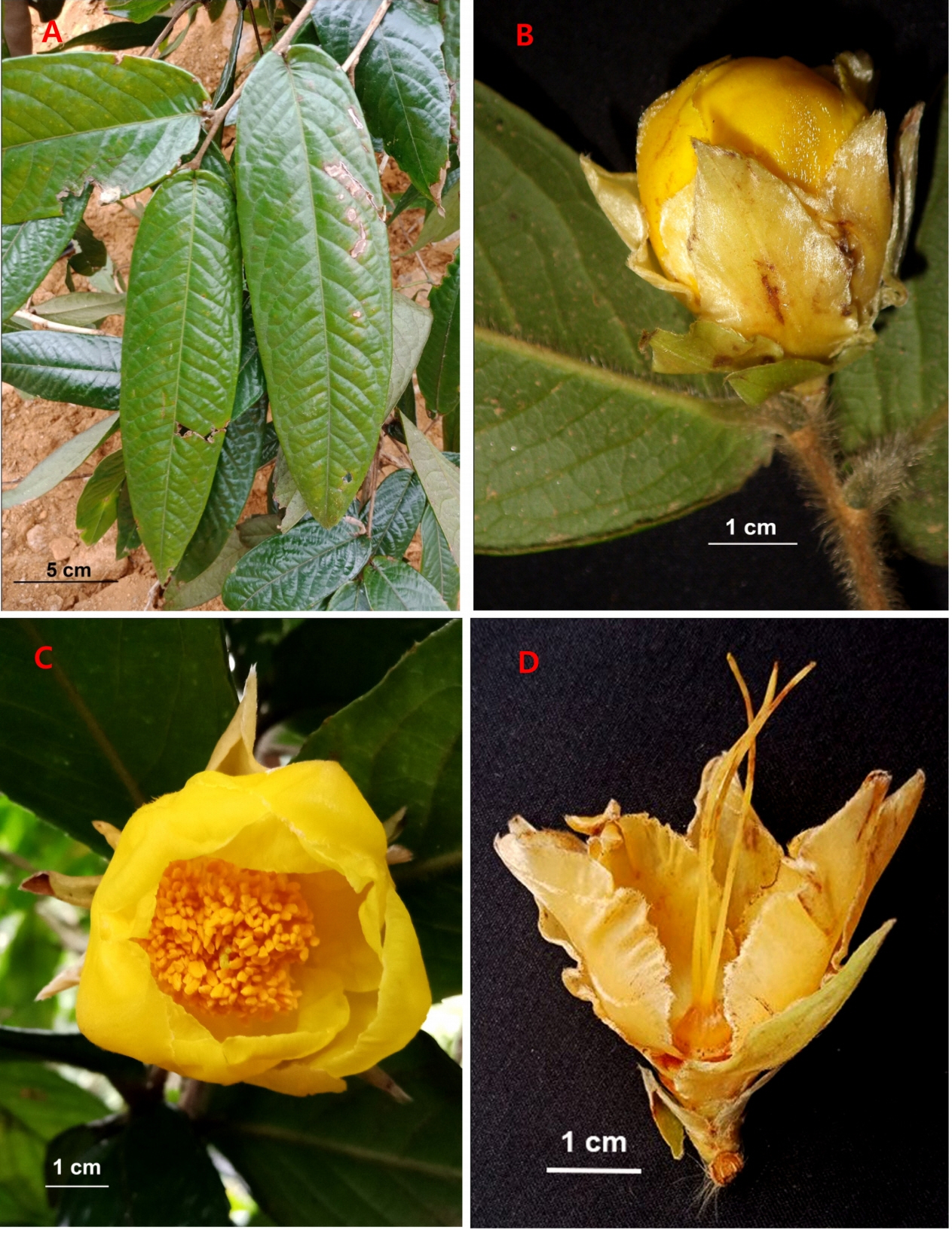Camellia, the largest genus of Theaceae, has its center of distribution in southern China and northern Vietnam (Chang and Bartholomew, 1984). The species number from 119 to 350, based on the opinion of various authors (Sealy, 1958; Chang and Bartholomew, 1984; Ming, 2000; Gao et al., 2005; Ming and Bartholomew, 2007). Vietnam, with more than 30 species of Camellia with yellow flowers (Le and Luong, 2016), is the center of diversity for plants with this feature. Among them are two species of yellow Camellia: C. pleurocarpa and C. quephongensis, in north-central Vietnam (including Thanh Hoa, Nghe An, Ha Tinh, Quang Binh, Quang Tri, and Thua Thien-Hue provinces). During a survey of the flora of the Pu Khang mountain range, Lien Hop Commune, Quy Hop District, Nghe An Province, we collected samples of a yellow Camellia that did not agree with either of them. After comparing it with closely related species, we determined it to be an undescribed species, which we here name C. pukhangensis.
Taxonomic Treatment
Camellia pukhangensis D.N. Do, D.V. Luong, S. T. Hoang & H.T. Le, sp. nov. (Figs. 1, 2).—TYPE: VIETNAM. Nghe An Province: Quy Hop District, 15 Jan 2018, Dai Ngoc Do & Huong Thi Le 186 (holotype: DLU).
Shrubs or small trees, 2–8 m tall, evergreen; young branches hirsute, becoming glabrous mature. Leaves shortly stalked; petiole 5–8 mm long, hirsute; blades oblong, 16–24 cm long, 5.5–8 cm wide, base cordate; margin serrate, apex attenuate to caudate, coriaceous, abaxially hirsute, adaxially hirsute only on midrib, lateral veins 16–20 pairs, abaxial veins protruding, adaxial midrib and lateral veins sunken. Flowers 5.5–6.5 cm in diameter, solitary at apex of branches, sessile or subsessile; bracteole and sepals indistinguishable (perules) 11–13, deltate to ovate, 0.3–4 cm long, 0.2–1.8 cm wide, abaxially hairy, margins ciliate. Petals 10–13, orbicular to obovate, bright yellow, 3–4.5 cm long, 2.3–4 cm wide, abaxially hairy, united with outermost filaments 1–1.5 cm at base. Stamens 350–390, in 5 or 6 series, light yellow, 3–3.5 cm long, pubescent to 2/3 from base, outer filaments united for 1.7–2 cm from base to form a cup; anthers yellow, 3–3.5 mm long, ca. 1 mm wide. Ovary with 3(or 4) loculi, ovoid, light yellow, 4–4.5 mm long, 4–5 mm wide, pubescent; styles 3(or 4), free to base, 3–3.2 cm long, pubescent. Capsules not seen.
Etymology: The specific epithet refers to the type location, Pu Khang Mountain in Nghe An Province, Vietnam, where it was discovered.
Phenology: Flowering from November to March; fruiting period unknown.
Distribution: Camellia pukhangensis occurs in forests in Lien Hop Commune, Quy Hop District, Nghe An Province, at altitudes of 500–900 m. It is scattered on mountain sides and among rocks in association with species of Clusiaceae, Euphorbiaceae, Melastomataceae, Myrtaceae, and Lauraceae.
Additional specimens examined: VIETNAM. Nghe An Province: Quy Hop District, 15 Jan 2018, Dai Ngoc Do & Huong Thi Le 187, 188 (DLU).
IUCN Red List category: Camellia pukhangensis is known from only one population of 122 individuals that occupies an area of less than 1 km2. The location is currently threatened by cutting and agricultural expansion, hence, the species is provisionally categorized as Critically Endangered (CR) B2a (IUCN, 2017).
Notes: Camellia pukhangensis is characterized by leaves abaxially hirsute and adaxially hirsute only along the midrib (section Eriandra Coh. St.); solitary flowers at the apex of branches, short pedicels, perules more than 10 (section Archecamellia Sealy); the gynoecium is 3(or 4) locular with three free styles (section Chrysantha Chang). However, species in section Eriandra are characterized by small leaves hairy only on the midrib, small white flowers, the androecium in 2 or 3 whorls and compound styles (Chang and Bartholomew, 1984; Ming and Bartholomew, 2007). Camellia pukhangensis has yellow petals, the androecium in 5 or 6 whorls and free styles. Section Chrysantha is characterized by 1–3 axillary flowers or flowers at the apex of branches, long pedicels, bracteoles and sepals distinguishable, 5–7 bracteoles, 5–7 persistent sepals, 8–12 yellow petals, the androecium in four whorls and the stamens connate into a short tube, the gynoecium glabrous or pubescent with 3–5 loculi and 3–5 free styles (Chang and Bartholomew, 1984; Ming and Bartholomew, 2007). Camellia pukhangensis has solitary, sessile or subsessile flowers at the end of branches and the bracteoles and sepals are indistinguishable. So the new species cannot belong to section Chrysantha. Section Archecamellia is characterized by flowers solitary at the end of branches, 11–16 persistent perules, 8–14 petals, glabrous or pubescent stamens connate into a cup, a glabrous or pubescent gynoecium with 3–5 loculi and 3 or 5 free styles (Sealy, 1958). The new species, C. pukhangensis, has many characteristics of section Archecamellia, such as solitary flowers at the end of branches,11–13 indistinguishable persistent perules, pubescent stamens connate into a cup, a pubescent gynoecium with 3(or 4) loculi and 3(or 4) free styles. Because of the similarity of the features, we place C. pukhangensisin section Archecamellia (C. euphlebia, C. flava, C. petelotii and C. tonkinensis) (Sealy, 1958; Gao et al., 2005; Yang et al., 2014). The main similarities and differences of the species of section Archecamellia are summarized in Table 1.













